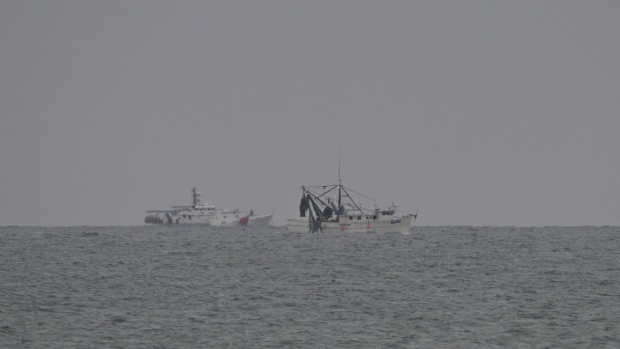Feb 5, 2023
US Moves to Recover Chinese Balloon While Weighing Retaliation
, Bloomberg News

(Bloomberg) -- The US sent divers to salvage what they believe is spy equipment from the Chinese balloon shot down off South Carolina, as pressure mounted on President Joe Biden to hit back at Beijing with new export controls on sensitive technology.
The government anticipates finding equipment capable of taking detailed photographs, along with other sensors, one person familiar with the matter said. US lawmakers are already demanding to know if the balloon’s payload contains technology from the US or its allies, another person said. Both asked not to be identified because the administration doesn’t want to reveal exactly what it suspects the balloon was carrying.
The balloon, said to be the size of at least two school buses, and its sensors are lying in 50 feet (15 meters) of water and scattered over a seven-mile (11-kilometer) area off Myrtle Beach. Divers and cranes operating from the surface were expected to haul it up in the coming days, potentially giving intelligence analysts crucial insight into Chinese spying capabilities.
While China says the device was a climate-research “airship” that strayed off course, the US argues it was part of a broader spying program by Beijing. With that in mind, Biden administration was calibrating how severely and swiftly to retaliate, people familiar with the matter said.
In a sign of more tension to come, the Chinese Foreign Ministry sharpened its tone Sunday after an American F-22 fighter jet popped the balloon with a Sidewinder missile and sent its payload crashing into the Atlantic Ocean. Beijing called the decision a “clear overreaction” and said it reserved the right to respond.
“China will resolutely safeguard the legitimate rights and interests of the company concerned, and reserves the right to make further responses if necessary,” Chinese Vice Foreign Minister Xie Feng said, according to a Foreign Ministry statement released Monday. Xie lodged a formal diplomatic protest with the US Embassy in Beijing, the ministry said.
Chinese stocks extended losses as the episode stoked fears of economic retaliation Monday, a day when investors had been expecting a relatively positive visit to Beijing by Secretary of State Antony Blinken. “Both sides will likely impose more export bans on technology in different industries,” Iris Pang, chief economist for Greater China at ING Groep NV, wrote in a note.
While the balloon may be out of the sky, the bizarre saga that surrounded it is far from over. Biden will almost certainly make reference to the episode in his State of the Union speech Tuesday, another person familiar with the matter said.
Blinken’s Trip
One option would be to send Blinken to China with a much tougher message than the one he had planned to bring this week, before he postponed the trip. People familiar with the matter said he didn’t want to risk the public-relations disaster of landing in Beijing while the balloon was still in the air over US territory.
Now, the administration believes Blinken should reschedule his trip soon. They argue for a much tougher approach both on the balloon and evidence the US has that officials say shows Chinese companies have been quietly supporting Russia’s war effort in Ukraine.
Chinese Foreign Ministry spokeswoman Mao Ning told a regular news briefing Monday in Beijing that it was up to the US to announce when Blinken would visit the country.
The episode is already ratcheting up pressure on the administration to push even harder with its existing strategy of trying to hobble China’s ability to access an array of high-tech semiconductors used in sophisticated military applications, as well as the valuable equipment used to manufacture such chips.
And even if it doesn’t spur specific new measures, the embarrassingly public act of alleged espionage has made it more difficult for the US and China to stabilize diplomatic ties over thorny issues such as Taiwan, particularly with the Biden administration facing growing pressure from critics and a Republican-controlled House of Representatives.
US Senate Majority Leader Chuck Schumer, a New York Democrat, said senators will get a full classified briefing on Feb. 15, which will give the administration time to collect and sort through the evidence to back up its claim. “The bottom line here is that shooting down the balloon over water wasn’t just the safest option, but it was the one that maximized our intel gain,” Schumer said in a statement.
Balloons like the one blown apart Saturday are not uncommon, but this time the Chinese made a mistake by flying it low enough to be spotted by commercial pilots and people on the ground, according to one person familiar with the matter. Typically balloons like the one shot down fly above 80,000 feet and as high as 100,000 feet.
The administration has already faced fierce Republican criticism in recent days for being weak on China and not shooting down the balloon sooner. US officials argued that it simply wasn’t safe to bring the floating orb down over land when it was carrying a large and heavy payload.
Divers from the US Navy’s Explosive Ordnance Disposal Mobile Salvage and Diving Unit 2 and cranes operating from the surface are expected to haul up the balloon’s payload in the coming days, according to a US defense official. The salvage operation is being managed by the commander of the USS Carter Hall, a dock landing vessel that normally carries US Marines and their equipment in an Amphibious Readiness Group, the official said.
The Ticonderoga-class cruiser USS Philippine Sea and the USS Oscar Austin, a guided missile destroyer, were guarding the operation along with three US Coast Guard cutters — the USCGC Venturous, USCGC Richard Snyder and USCGC Nathan Bruckenthal.
--With assistance from Peter Martin, Victoria Cavaliere, Zibang Xiao, April Ma and Tony Capaccio.
(Updates with Chinese Foreign Ministry under Blinken’s Trip subheadline.)
©2023 Bloomberg L.P.


